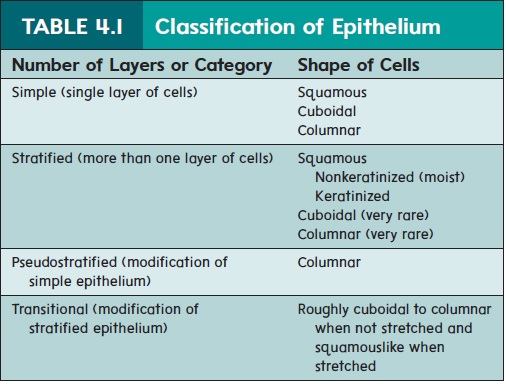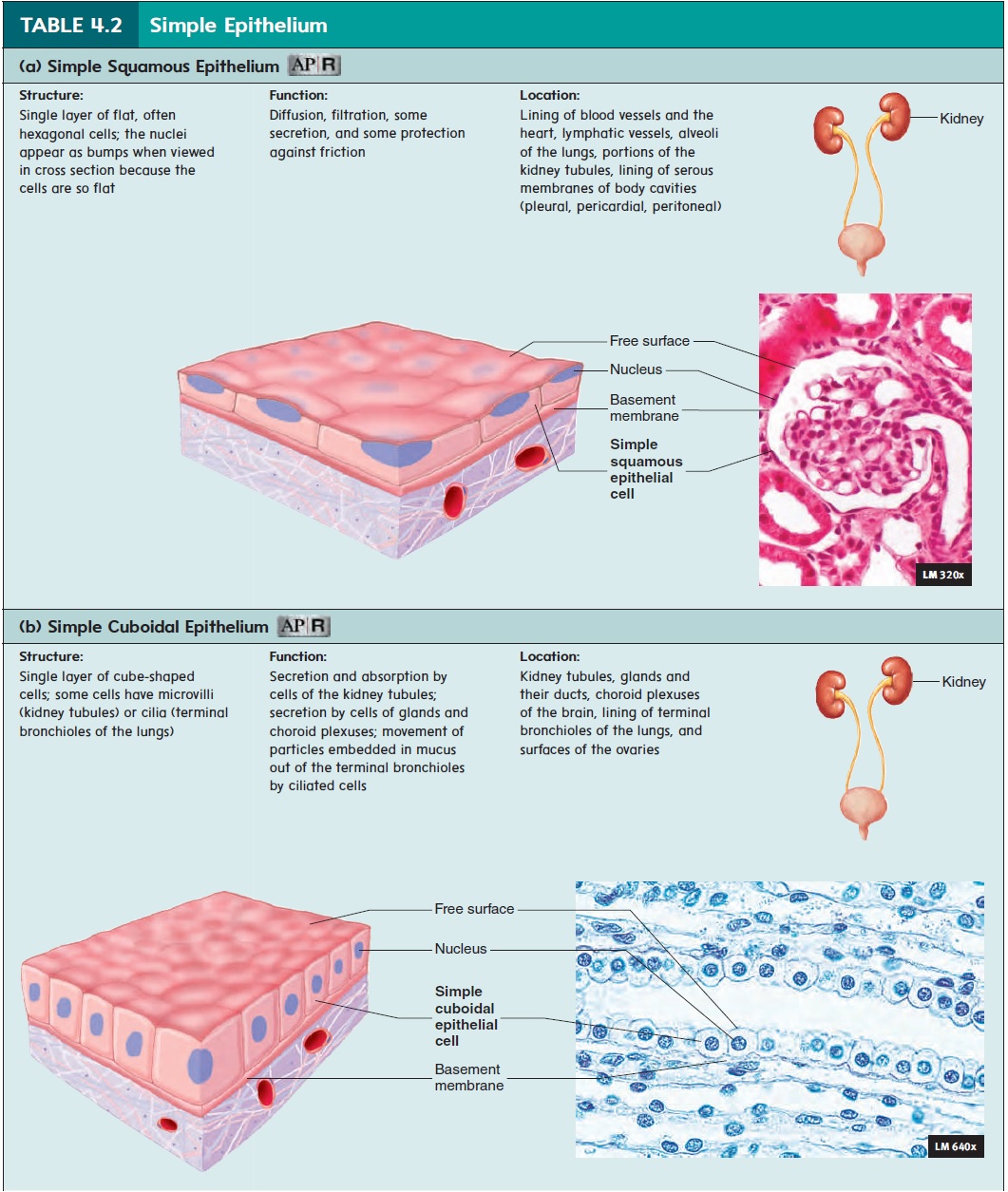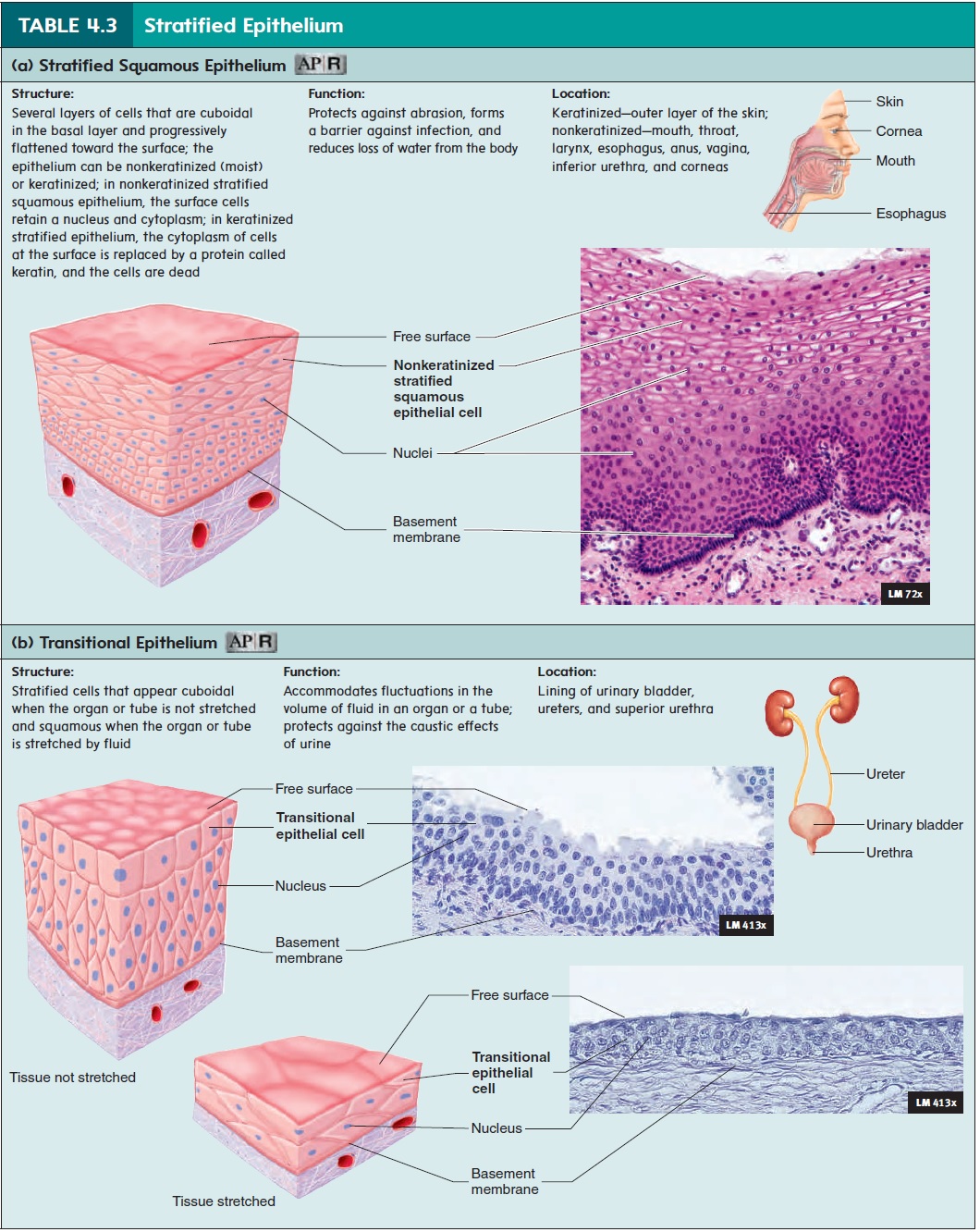Chapter: Essentials of Anatomy and Physiology: Tissues
Classification of Epithelia
Classification of Epithelia
Epithelia are classified according to the number of cell layers and the shape of the cells (table 4.1). Simple epithelium consists of a single layer of cells. Stratified epithelium consists of more than one layer of epithelial cells, with some cells sitting on top of others. Categories of epithelium based on cell shape are squamous (skwā′\mŭs; flat), cuboidal (cubelike), and columnar (tall and thin). In most cases, each epithelium is given two names, such as simple squamous, simple columnar, or stratified squamous epithelium. When epithelium is stratified, it is named according to the shape of the cells at the free surface.

Simple squamous epithelium is a single layer of thin, flat cells (table 4.2a). Some substances easily pass through this thin layer of cells, but other substances do not. For example, the air-ways end as small sacs called alveoli (al-vē′\o-lı̄; sing. alveolus, hollow sac). The alveoli consist of simple squamous \epithelium that allows oxygen from the air to diffuse into the body and carbon dioxide to diffuse out of the body into the air. Simple squamous epithelium in the filtration membranes of the kidneys forms thin barriers through which small molecules, but not large ones, can pass.

Small molecules, including water from blood, are filtered through these barriers as a major step in urine formation. Large molecules, such as proteins, and blood cells remain in the blood vessels of the kidneys.
Simple squamous epithelium also prevents abrasion between organs in the pericardial, pleural, and peritoneal cavities . The outer surfaces of organs are covered with simple squamous epithelium that secretes a slippery fluid. The fluid lubri-cates the surfaces between the organs, preventing damage fromfriction when the organs rub against one another or the body wall.
Simple cuboidal epithelium is a single layer of cubelikecells (table 4.2b) that carry out active transport, facilitated dif-fusion, or secretion. Epithelial cells that secrete molecules such as proteins contain organelles that synthesize them. These cells have a greater volume than simple squamous epithelial cells and contain more cell organelles. The kidney tubules have large portions of their walls composed of simple cuboidal epithelium. These cells secrete waste products into the tubules and reabsorb useful materials from the tubules as urine is formed. Some cuboidal epithelial cells have cilia that move mucus over the free surface or microvilli that increase the surface area for secretion and absorption.
Pseudostratified columnar epithelium is a special type ofsimple epithelium (table 4.2d). The prefix pseudo- means false, so this type of epithelium appears stratified but is not. It consists of one layer of cells, with all the cells attached to the basement mem-brane. But it looks like two or more layers of cells because some of the cells are tall and reach the free surface, whereas others are short and do not reach the free surface. Pseudostratified columnar epithelium lines some glands and ducts, the auditory tubes, and some of the airways, such as the nasal cavity, nasal sinuses, phar-ynx, trachea, and bronchi. Pseudostratified columnar epithelium secretes mucus, which covers its free surface. Cilia located on the free surface move the mucus and the debris that accumulates in it. For example, cilia of the airways move mucus toward the throat, where it is swallowed.
Stratified squamous epithelium forms a thick epithelium because it consists of several layers of cells (table 4.3a). The deepest cells are cuboidal or columnar and are capable of dividing and producing new cells. As these newly formed cells are pushed to the surface, they become flat and thin. As the cells flatten, the cyto-plasm of the epithelial cells is replaced by a protein called keratin, and the cells die. One type of stratified squamous epithelium forms the outer layer of the skin and is called keratinized squa-mous epithelium . The dead cells provide protection against abrasion, and form a barrier that prevents microorganisms and toxic chemicals from entering the body, and reduces the loss of water from the body. If cells at the surface are damaged or rubbed away, they are replaced by cells formed in the deeper layers.

In contrast, stratified squamous epithelium of the mouth is composed of living cells with a moist surface. This nonkeratinized (moist) stratified squamous epithelium also provides protection against abrasion and acts as a mechanical barrier, preventing microorganisms from entering the body. Water, however, canmove across it more readily than across the skin.
Stratified cuboidal epithelium consists of more than onelayer of cuboidal epithelial cells. This epithelial type is relatively rare and is found in sweat gland ducts, ovarian follicular cells, and the salivary glands. It functions in absorption, secretion, and protection.
Stratified columnar epithelium consists of more than one layer of epithelial cells, but only the surface cells are columnar. The deeper layers are irregular or cuboidal in shape. Like stratified cuboidal epithelium, stratified columnar epithelium is relatively rare. It is found in the mammary gland ducts, the larynx, and a portion of the male urethra. This epithelium carries out secretion,protection, and some absorption.
Transitional epithelium is a special type of stratified epithe-lium that can be greatly stretched (table 4.3b). In the unstretched state, transitional epithelium consists of five or more layers of cuboidal or columnar cells that often are dome-shaped at the free surface. As transitional epithelium is stretched, the cells change to a low cuboidal or squamous shape, and the number of cell layers decreases. Transitional epithelium lines cavities that can expand greatly, such as the urinary bladder. It also protects underlying structures from the caustic effects of urine.
Related Topics